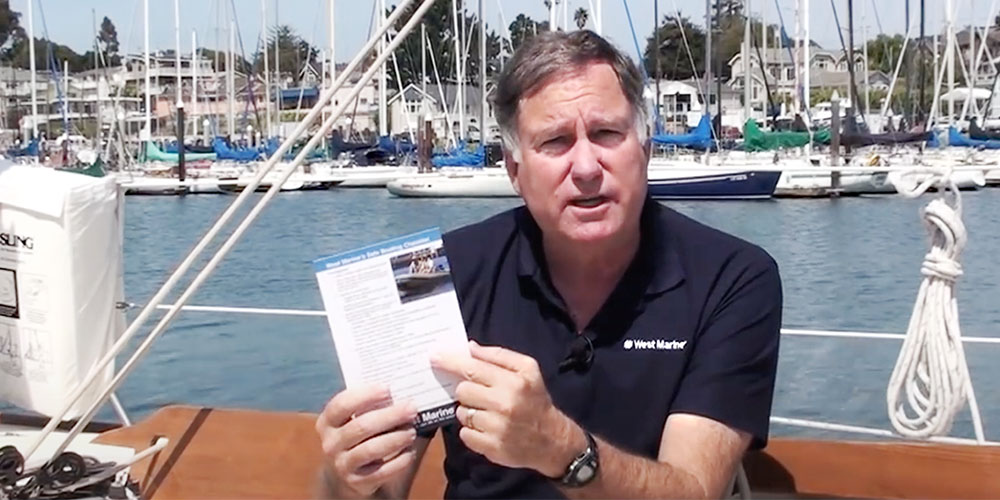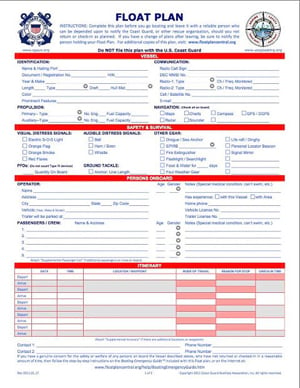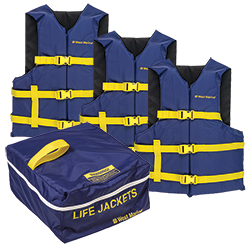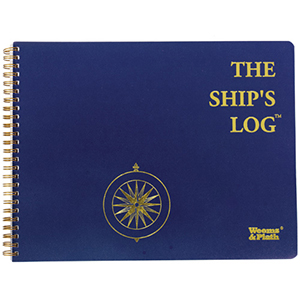
While this list is geared toward small day cruisers and larger boats, if you own a small runabout or kayak, the concept of preparedness still applies. For an overview of required and recommended safety equipment for all types of boats, see our Do-it-Yourself West Advisor on Safety Equipment.
- Important Downloads
- Before Departure
- On the Water
- When You Return to the Dock
- Safe Boating Checklist FAQs
- We’re Here to Help!
- Related Articles
Important Downloads

Download this USCG Float Plan
Before Departure
Check weather forecasts, tides and currents
File a float plan with a trusted contact ashore
Follow safe fueling practices; make sure engine room blower fan is in working order
Check operation of bilge pump, auto switch and alarms
Ensure you have appropriate-size life jackets in good repair and make sure all children onboard wear them at all times
Brief crew on locations and operation of safety equipment including: life jackets, life sling, or throwable flotation; sound-producing device; flares/visual distress signals; fire extinguishers; and a spare engine cutoff lanyard, if equipped

Keeping a few inexpensive life jackets onboard, like these All Family Runabout Life Vests helps to ensure that you never get caught short.
Turn on VHF radio. Show passengers how to select Ch. 16, how to use mic, and when/how to transmit a Mayday. Brief on how/when to use and not use the DSC feature if you have it; ensure the MMSI is programmed in
Check operation of navigation/running lights
Ensure that one anchor and rode is ready for immediate use
Before starting a gasoline inboard engine, run blower for at least 4 minutes
Attach engine shutoff switch lanyard or device, if fitted
On the Water
Store a “go home” waypoint on the GPS as you depart the harbor
Know the waters you’re navigating. Refer to local charts, stay within marked channels, be aware of tides, currents, and areas such as inlets with challenging seas
Avoid distracted driving, scan the horizon continually for other boats’ movements
Be weather-aware (watch for wind/cloud changes, monitor weather channels)
While underway, no passengers on the bow, gunwales, or transom
Monitor fuel consumption and remaining range. Use the “Three-Thirds” rule: one-third outbound, one-third inbound, one-third reserve
Designate a lookout if engaging in watersports activities
Turn the engines off if people are swimming
Drink plenty of water, wear sunscreen and don’t boat under the influence
When You Return to the Dock

Log books like this one by Weems & Plath are available in versions to suit a variety of needs.
Moor boat correctly with bow, stern, spring lines and fenders. Ensure dock lines are protected from chafe. Ensure snubbers (if so equipped) are in place.
Pump holding tank. Add holding tank treatment.
Ensure that always-on loads (automatic bilge pump, alarms, clocks) are on.
Ensure non-essential loads (running lights, VHF, stereo, etc.) are off.
Connect shore power cable and ensure it is protected from chafe. Turn on the battery charger. Ensure inverter is turned on or off as needed.
Fill out, sign and date logbook.
Close float plan by calling person whom you originally contacted.
This checklist was created by West Marine as a public service. We practice and encourage safe boating and seamanship.
Safe Boating Checklist FAQs
Why is filing a float plan important?
Filing a float plan ensures someone ashore knows your intended route and expected return time, helping authorities locate you quickly in case of an emergency.
What safety equipment should I check before departure?
Ensure life jackets are in good condition, brief passengers on emergency gear, check fire extinguishers, test the bilge pump, and confirm the VHF radio and navigation lights are working.
How can I prevent fuel-related accidents?
Follow safe fueling practices, ensure blower fans work, and run the blower for at least four minutes before starting a gasoline inboard engine.
What’s the best way to navigate safely on the water?
Use local charts, stay within marked channels, be aware of tides and currents, monitor weather conditions, and designate a lookout when needed.
How do I properly use a VHF radio in an emergency?
Turn on the VHF, select Channel 16, press the mic button, state “Mayday” three times, provide your boat’s name, location, and nature of distress, then release the button to listen for a response.
What should I do when returning to the dock?
Secure the boat with bow, stern, and spring lines, pump out the holding tank, turn off non-essential electronics, connect shore power, and close your float plan.
How can I conserve fuel while boating?
Follow the “Three-Thirds” rule: use one-third of your fuel outbound, one-third inbound, and reserve one-third for emergencies.
Why should I turn off the engine when people are swimming?
Engines pose a risk of propeller injuries and carbon monoxide exposure. Always turn off the engine and ensure everyone is clear before restarting.
We’re Here to Help!
At West Marine, we’re committed to safe and enjoyable boating. Whether you need life jackets, safety gear, navigation tools, or other essentials, we have everything to keep you prepared. Shop online or visit one of our 230+ stores for expert advice and the best selection. Use our store locator to find your nearest West Marine!